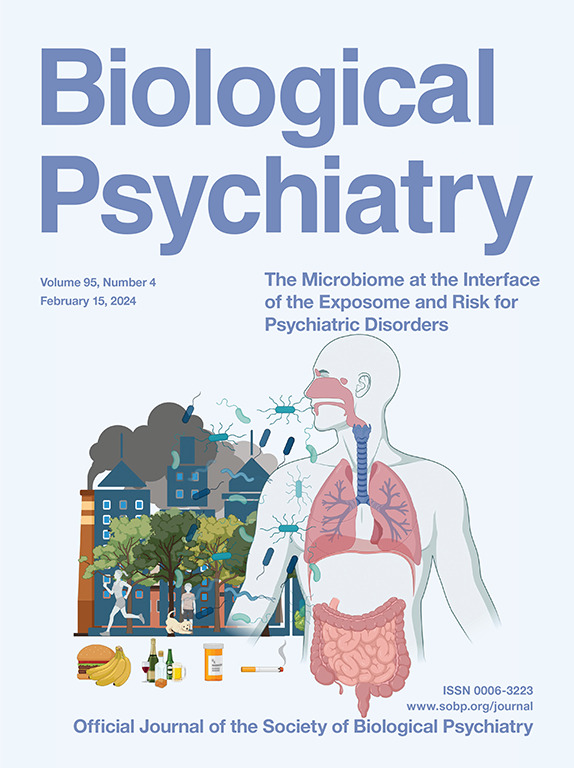严格评估 "如何、在何处以及何时通过经颅磁刺激诱导创伤后应激障碍网络的可塑性 "这一悬而未决的问题。
IF 9
1区 医学
Q1 NEUROSCIENCES
引用次数: 0
摘要
创伤记忆的消退是创伤后应激障碍(PTSD)的一种主要治疗方法(称为暴露疗法),它是通过重新学习来实现的,并可能在分子水平上通过相关回路的长期电位(LTP)来实现。与此同时,重复经颅磁刺激(rTMS)也被认为是通过类似于 LTP 的机制发挥作用,并可能为创伤后应激障碍提供一种新型、安全且有效的治疗方法。我们最近失败的随机对照试验(1)强调了正确识别皮层目标、经颅磁刺激方案的方向性以及记忆激活作用的必要性。在此,我们对 TMS 治疗创伤后应激障碍进行了系统综述,以进一步确定应如何、在何处以及何时进行 TMS 治疗来缓解创伤后应激障碍症状。我们对涉及创伤后应激障碍患者的经颅磁刺激临床试验及其结果进行了系统性的文献综述。我们在 2023 年 10 月 25 日之前的 MEDLINE 中搜索了 "TMS 与创伤后应激障碍 "和 "经颅磁刺激与创伤后应激障碍"。有 31 篇出版物符合我们的纳入标准(k=17 项随机对照试验 (RCT),k=14 项开放标签试验)。随机对照试验方案在 TMS 方案、皮层 TMS 目标和记忆激活方案方面各不相同。低频方案(k=5)与高频方案(k=6)之间或刺激位置之间没有明显的优劣之分。记忆激发或暴露方案(k=7)似乎能增强反应。总的来说,在不同的TMS频率、半球目标差异和暴露方案下,TMS似乎都能有效治疗创伤后应激障碍症状。如果将不同的治疗方案视为增强拟焦虑网络或抑制焦虑网络,那么它们在概念上可能是一致的。本文章由计算机程序翻译,如有差异,请以英文原文为准。
Critically Assessing the Unanswered Questions of How, Where, and When to Induce Plasticity in the Posttraumatic Stress Disorder Network With Transcranial Magnetic Stimulation
Extinction of traumatic memory, a primary treatment approach (termed exposure therapy) in posttraumatic stress disorder (PTSD), occurs through relearning and may be subserved at the molecular level by long-term potentiation of relevant circuits. In parallel, repetitive transcranial magnetic stimulation (TMS) is thought to work through long-term potentiation–like mechanisms and may provide a novel, safe, and effective treatment for PTSD. In a recent failed randomized controlled trial we emphasized the necessity of correctly identifying cortical targets, the directionality of TMS protocols, and the role of memory activation. Here, we provide a systematic review of TMS for PTSD to further identify how, where, and when TMS treatment should be delivered to alleviate PTSD symptoms. We conducted a systematic review of the literature by searching for repetitive TMS clinical trials involving patients with PTSD and outcomes. We searched MEDLINE through October 25, 2023, for “TMS and PTSD” and “transcranial magnetic stimulation and posttraumatic stress disorder.” Thirty-one publications met our inclusion criteria (k = 17 randomized controlled trials, k = 14 open label). Randomized controlled trial protocols were varied in terms of TMS protocols, cortical TMS targets, and memory activation protocols. There was no clear superiority of low-frequency (k = 5) versus high-frequency (k = 6) protocols or by stimulation location. Memory provocation or exposure protocols (k = 7) appear to enhance response. Overall, TMS appears to be effective in treating PTSD symptoms across a variety of TMS frequencies, hemispheric target differences, and exposure protocols. Disparate protocols may be conceptually harmonized when viewed as potentiating proposed anxiolytic networks or suppressing anxiogenic networks.
求助全文
通过发布文献求助,成功后即可免费获取论文全文。
去求助
来源期刊

Biological Psychiatry
医学-精神病学
CiteScore
18.80
自引率
2.80%
发文量
1398
审稿时长
33 days
期刊介绍:
Biological Psychiatry is an official journal of the Society of Biological Psychiatry and was established in 1969. It is the first journal in the Biological Psychiatry family, which also includes Biological Psychiatry: Cognitive Neuroscience and Neuroimaging and Biological Psychiatry: Global Open Science. The Society's main goal is to promote excellence in scientific research and education in the fields related to the nature, causes, mechanisms, and treatments of disorders pertaining to thought, emotion, and behavior. To fulfill this mission, Biological Psychiatry publishes peer-reviewed, rapid-publication articles that present new findings from original basic, translational, and clinical mechanistic research, ultimately advancing our understanding of psychiatric disorders and their treatment. The journal also encourages the submission of reviews and commentaries on current research and topics of interest.
 求助内容:
求助内容: 应助结果提醒方式:
应助结果提醒方式:


